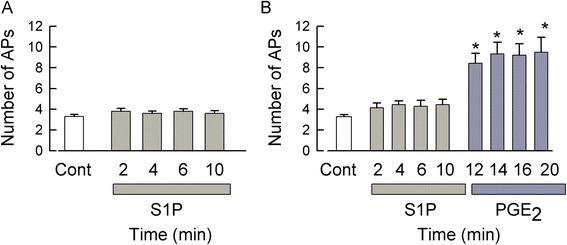Figure 6.

W146, a selective S1PR1 antagonist, and CAY10444, a selective S1PR3 antagonist, together abolished the sensitizing effect of S1P, but not PGEx2. (A) Pretreatment with 1 μM W146 and 10 μM CAY10444 for 30 min blocked the sensitization produced by 1 μM S1P. Results were obtained from ten sensory neurons (P = 0.15 Friedman RM ANOVA on ranks). (B) In another series of experiments, pretreatment with W146 and CAY10444 for 30 min blocked the sensitization produced by 1 μM S1P; however, subsequent exposure to 1 μM PGE2 significantly increased the number of evoked APs (n = 7 control through 12 min, n = 6, 5, and 4 for 14, 16, and 20 min, respectively). The asterisks (*) represent a statistical difference compared to the 10-min S1P results (P < 0.05 Kruskal-Wallis ANOVA on ranks followed by Dunn’s post hoc test). The 10-min S1P results were not different from the control values. AP - action potential, Cont - control, PGE2 - prostaglandin E2, S1P - sphingosine-1-phosphate.
